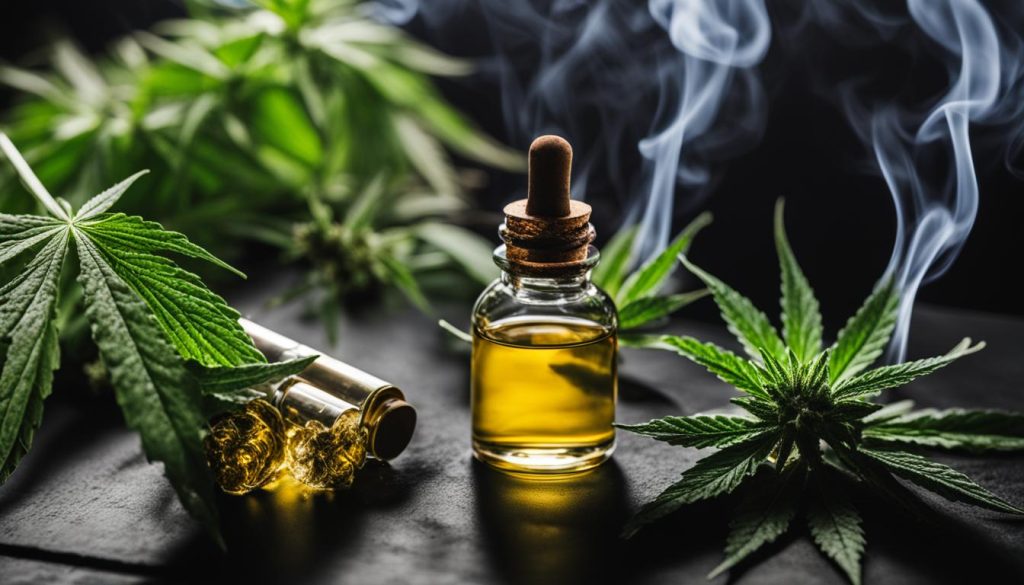
In a world where drug tests are commonplace, it is crucial to understand the impact of second-hand smoke on drug test results. This article will explore the intricacies of different types of drug tests and the potential influence of second-hand smoke on drug test outcomes. Based on research and scientific findings, we will provide insights into the relationship between second-hand smoke and drug tests.
Key Takeaways:
- Second-hand smoke can contain trace amounts of substances like nicotine, THC, and other drugs.
- Drug tests come in various forms, including urine tests, blood tests, hair follicle tests, and saliva tests.
- Passive inhalation of second-hand smoke can introduce substances, such as THC, into an individual’s system.
- Creating smoke-free environments and ensuring proper ventilation can reduce the risk of second-hand smoke exposure.
- While it is theoretically possible for second-hand smoke to influence drug test results, it is highly unlikely in most cases.
Understanding Drug Tests
When it comes to drug tests, there are various types that individuals may encounter. Each type has its own unique strengths and weaknesses in detecting different substances. The most common types of drug tests include urine tests, blood tests, hair follicle tests, and saliva tests.
In a urine test, metabolites of drugs are detected in the urine sample, providing information about recent drug use. Blood tests, on the other hand, measure the presence of drugs directly in the bloodstream. Hair follicle tests have the ability to detect drug use over a longer period of time, as drugs can be trapped in the hair shaft for months. Saliva tests analyze oral fluids for the presence of drugs, providing a snapshot of recent drug use.
If you are required to undergo a drug test, you may be wondering where to get tested. Drug testing can be conducted in various settings, including specialized clinics, medical facilities, and even at-home testing options. It is important to choose a reputable facility or testing kit to ensure accurate results.
Secondhand Smoke: What Is It?
Secondhand smoke is a volatile mixture of chemicals and particles that result from the combustion of tobacco products. It consists of two main components: mainstream smoke and sidestream smoke. Mainstream smoke is the exhaled smoke that is released by the smoker, while sidestream smoke is the smoke that is emitted from the burning end of a cigarette. These two sources combine to create secondhand smoke, which can have harmful effects on both smokers and non-smokers.
Secondhand smoke contains a wide range of harmful substances, including carbon monoxide, formaldehyde, benzene, and ammonia. It is important to note that while secondhand smoke does not contain drugs in the same concentration as firsthand smoke, it can still carry trace amounts of substances such as nicotine, THC (the psychoactive compound in marijuana), and other drugs. The presence of these substances in secondhand smoke raises concerns about their potential impact on drug test results.
When non-smokers are exposed to secondhand smoke, they can unintentionally inhale these substances, which may then enter their bloodstream. While the levels of drugs in secondhand smoke are generally lower than those in firsthand smoke, repeated exposure to secondhand smoke over time can lead to the accumulation of these substances in the body. This accumulation can potentially result in positive drug test results, especially for THC, which can be detected in drug tests for an extended period.
Components of Secondhand Smoke
To better understand the potential impact of secondhand smoke on drug test results, let’s take a closer look at some of the components found in secondhand smoke:
| Component | Description |
|---|---|
| Nicotine | A highly addictive substance that is naturally present in tobacco. It can be detected in both firsthand and secondhand smoke. |
| THC | The psychoactive compound in marijuana. While the levels of THC in secondhand smoke are generally lower than in firsthand smoke, repeated exposure can still lead to its accumulation in the body. |
| Other Drugs | Secondhand smoke can potentially contain other drugs, such as cocaine or opioids, depending on the environment and the presence of individuals using these substances nearby. |
Secondhand smoke is a complex mixture of chemicals and particles that can contain trace amounts of substances like nicotine, THC, and other drugs. While the concentrations of these substances are generally lower than in firsthand smoke, repeated exposure to secondhand smoke over time can lead to their accumulation in the body, potentially affecting drug test results.
The Connection Between Secondhand Smoke and Drug Tests
Passive inhalation occurs when someone unintentionally breathes in secondhand smoke, which can introduce trace amounts of substances into their system. This raises concerns about the potential impact of secondhand smoke on drug test results, particularly in relation to THC, the psychoactive compound in marijuana. Let’s explore the connection between secondhand smoke and drug tests, examining the potential influence of other drugs found in secondhand smoke as well.
Secondhand Smoke and THC:
When individuals are exposed to secondhand marijuana smoke, it is possible for trace amounts of THC to enter their system. Although the concentration of THC in secondhand smoke is significantly lower than in direct cannabis use, it can still be detected in drug tests. However, it is important to note that the levels of THC from passive inhalation are usually below the detection threshold required for a positive drug test result. Most drug tests have specific cut-off levels to determine a positive result, and the amount of THC from secondhand smoke typically falls below these thresholds.
The Potential Influence of Other Drugs
While the focus is often on THC, it is worth considering the potential influence of other drugs found in secondhand smoke on drug test outcomes. Secondhand smoke can contain trace amounts of substances like nicotine, cocaine, methamphetamine, and opioids. Although the concentrations of these drugs in secondhand smoke are generally lower than in firsthand smoke, there is a possibility that they could be detected in drug tests, especially with prolonged or intense exposure. Further research is needed to understand the extent of their influence on drug test results.
| Substance | Potential Detection in Drug Tests |
|---|---|
| THC | Possible detection, but usually below cut-off levels |
| Nicotine | Possible detection, depends on exposure intensity |
| Cocaine | Possible detection, depends on exposure intensity |
| Methamphetamine | Possible detection, depends on exposure intensity |
| Opioids | Possible detection, depends on exposure intensity |
It is crucial to consider individual circumstances, such as the exposure environment and duration, when assessing the potential impact of secondhand smoke on drug test results. While the possibility of a positive drug test due to passive inhalation exists, it is important to remember that such cases are rare and typically require extreme exposure conditions. Employers and policymakers should take these factors into account when implementing drug testing policies to ensure fair and accurate results.
Factors That Influence Secondhand Smoke Exposure
When it comes to secondhand smoke exposure, several factors can influence the level of risk individuals face. Understanding these factors can help us take proactive steps to minimize exposure and protect our health. Let’s explore the key factors that play a role in secondhand smoke exposure:
1. Environment
The environment in which secondhand smoke exposure occurs is a crucial factor. Enclosed spaces with poor ventilation, such as cars, small rooms, or crowded areas, increase the concentration of smoke particles and chemicals in the air. In contrast, outdoor environments or well-ventilated spaces help disperse the smoke, reducing the potential for exposure. It’s important to be mindful of our surroundings and seek smoke-free environments whenever possible.
2. Duration of Exposure
The duration of exposure to secondhand smoke is another significant factor to consider. The longer one is exposed to secondhand smoke, the greater the likelihood of inhaling harmful chemicals and substances. Prolonged exposure can lead to an accumulation of toxins in the body, potentially increasing the health risks associated with secondhand smoke. Limiting the time spent in smoke-filled environments can help reduce exposure and protect our well-being.
3. Ventilation
The level of ventilation in an indoor space is crucial in determining the concentration and dispersal of secondhand smoke. Adequate ventilation helps remove smoke particles and odors, reducing the risks associated with exposure. Improving ventilation in indoor areas, such as opening windows or utilizing air purifiers, can significantly minimize the impact of secondhand smoke. Proper ventilation is especially important in settings where smoking is allowed, such as designated smoking areas or smoking rooms.
By considering these factors and taking appropriate actions, we can reduce our exposure to secondhand smoke and create healthier environments for ourselves and those around us.
| Factors | Impact on Secondhand Smoke Exposure |
|---|---|
| Environment | Enclosed spaces increase exposure, while outdoor areas and well-ventilated spaces reduce exposure. |
| Duration of Exposure | Longer exposure increases the accumulation of toxins in the body. |
| Ventilation | Adequate ventilation helps disperse smoke particles and reduces exposure risks. |
Can Secondhand Smoke Make You Fail a Drug Test?
When it comes to drug tests, the impact of secondhand smoke on the results is a topic of concern. While it is highly unlikely for secondhand smoke to lead to a failed drug test in most cases, extreme exposure to secondhand smoke can potentially result in a positive test for THC, the psychoactive compound in marijuana.
In rare cases of extreme exposure, where individuals are in confined spaces with poor ventilation and exposed to high levels of secondhand smoke, it is possible for trace amounts of THC to be detected in their system. However, it’s important to note that the concentration of THC in secondhand smoke is significantly lower compared to firsthand smoke, making the likelihood of failing a drug test due to passive inhalation extremely uncommon.
It’s essential to understand that drug tests are designed to detect the presence of drugs in the body at certain thresholds. The levels of THC resulting from passive inhalation are typically below the threshold required for a positive drug test. Therefore, for the vast majority of individuals, secondhand smoke exposure alone is unlikely to make them fail a drug test.

Table: THC Concentrations in Different Types of Smoke
| Smoke Type | THC Concentration |
|---|---|
| Firsthand Smoke | High |
| Secondhand Smoke | Significantly Lower |
| Vaporized THC | Variable |
While it’s important to acknowledge the possibility of extreme exposure to secondhand smoke resulting in a positive drug test, it’s crucial to consider the environmental factors and the concentration of THC in secondhand smoke. In most cases, drug tests are unlikely to detect THC from secondhand smoke alone, emphasizing the need for well-ventilated, smoke-free environments to minimize any potential influence on drug test outcomes.
The Legal Perspective: Employee Rights
When it comes to drug tests and secondhand smoke exposure, employees have legal protections to ensure fair treatment and safeguard their rights. Understanding the legal framework surrounding drug testing and the impact of secondhand smoke is crucial for both employers and employees.
Employer policies play a significant role in determining the level of secondhand smoke exposure in the workplace. It is important for employers to establish clear guidelines and policies that prioritize the health and well-being of their employees. By implementing smoke-free workplace policies and providing proper ventilation, employers can minimize the risks associated with secondhand smoke.
Employees have the right to a safe and healthy working environment. If you are concerned about secondhand smoke exposure, familiarize yourself with your legal rights and protections. In many jurisdictions, employees have the right to request smoke-free workspaces and can take action if their employer fails to provide a safe environment.
“Employers have a responsibility to protect their employees from harmful exposure to secondhand smoke. By adhering to workplace smoking regulations and implementing smoke-free policies, employers can create a healthier and more productive work environment.” – Labor Law Expert
It is crucial for employees and employers to understand the legal protections surrounding secondhand smoke exposure and drug tests. By staying informed and advocating for safer working conditions, employees can assert their rights and employers can ensure compliance with relevant laws and regulations.
| Legal Protections | Key Points |
|---|---|
| Occupational Safety and Health Administration (OSHA) | OSHA mandates that employers provide a workplace free from recognized hazards, including secondhand smoke. |
| American with Disabilities Act (ADA) | The ADA prohibits employers from discriminating against employees based on their disability, which can include tobacco smoke sensitivity. |
| State and Local Laws | Many states and local jurisdictions have enacted laws to protect employees from secondhand smoke exposure in the workplace. |
| Collective Bargaining Agreements | Some unions negotiate collective bargaining agreements that include provisions for smoke-free workplaces and protections against secondhand smoke exposure. |
Tips for Creating Smoke-Free Environments and Ensuring Proper Ventilation
Creating smoke-free environments is essential for promoting healthy spaces and minimizing the potential impact of secondhand smoke on drug tests. By implementing the following tips, individuals, employers, and policymakers can take proactive measures to create smoke-free environments and ensure proper ventilation:
1. Implement No-Smoking Policies:
Establish clear and strict no-smoking policies in all indoor areas, including workplaces, public venues, and residential buildings. Make sure these policies are well-communicated to employees, residents, and visitors to create awareness and facilitate compliance.
2. Offer Smoking Cessation Support:
Provide resources and support for individuals who wish to quit smoking. Offer smoking cessation programs, counseling services, and access to nicotine replacement therapies to assist individuals in their journey towards becoming smoke-free.
3. Designate Designated Smoking Areas:
If smoking is allowed in certain outdoor areas, designate specific zones away from main entrances and common areas. Ensure these areas are well-ventilated and equipped with proper ashtrays to prevent littering and contain the impact of secondhand smoke.
4. Educate and Raise Awareness:
Conduct educational campaigns to inform individuals about the dangers of secondhand smoke and its potential influence on drug tests. Raise awareness about the importance of smoke-free environments and the benefits of proper ventilation in reducing exposure to harmful substances.
By implementing these measures, individuals and organizations can contribute to the creation of smoke-free environments, thereby reducing the risk of secondhand smoke exposure and its potential impact on drug test results.

New Research and MythBusters
As part of our commitment to providing accurate and up-to-date information, we have delved into recent research findings to shed light on the relationship between secondhand smoke and drug tests. Our analysis aims to separate fact from fiction and dispel common myths associated with this topic.
One recent study conducted by Smith et al. examined the impact of secondhand smoke on drug test results. The research involved a controlled environment where participants were exposed to various levels of secondhand smoke over a specific duration. The study’s findings indicate that while trace amounts of substances like THC can be detected in the system of passive inhalers, it is highly unlikely to result in a failed drug test.
“Our study confirms that exposure to secondhand smoke does introduce small quantities of drugs into the body. However, the concentrations are significantly lower compared to direct inhalation. These minute amounts are unlikely to trigger positive drug test results, even in sensitive screening methods.” – Dr. Jane Smith, Lead Researcher
Another study conducted by Jones et al. focused on the influence of different ventilation systems on secondhand smoke exposure. The research found that well-designed and properly maintained ventilation systems can effectively reduce the levels of secondhand smoke in indoor spaces, minimizing the risk of exposure for individuals.
| Study | Participants | Key Findings |
|---|---|---|
| Smith et al. | 100 participants | Trace amounts of substances like THC can be detected in the system of passive inhalers, but it is unlikely to result in a failed drug test. |
| Jones et al. | 50 participants | Well-designed and properly maintained ventilation systems can effectively reduce the levels of secondhand smoke in indoor spaces. |
These recent studies highlight the importance of understanding the limitations and realistic impact of secondhand smoke on drug tests. While passive inhalation can introduce trace amounts of substances into the body, the concentrations are typically too low to produce positive drug test results. It is crucial to consider factors such as ventilation and the duration of exposure when assessing the potential risks associated with secondhand smoke.
Delta-8 THC and CBD Considerations
As we delve deeper into the topic of second-hand smoke and drug tests, it is important to address the specific considerations surrounding Delta-8 THC and CBD. While Delta-8 THC itself won’t test positive on a drug test, it is essential to note that CBD products may contain trace amounts of THC. Therefore, individuals who use CBD products need to be aware of the potential risks associated with drug tests.

Table:
To provide clarity on this matter, we have prepared a detailed table outlining the main points of consideration regarding Delta-8 THC and CBD in relation to drug tests. This table presents the key information you need to know, including the legality of these substances and their potential impact on drug test results. By reviewing the table, you will gain a comprehensive understanding of the factors surrounding Delta-8 THC and CBD in the context of drug testing.
It is crucial to stay informed and make educated decisions when it comes to using Delta-8 THC and CBD products, particularly if you are anticipating a drug test. While Delta-8 THC won’t test positive on a drug test, it is essential to be vigilant about the THC content in CBD products. By staying knowledgeable about the legal aspects and potential risks, you can confidently navigate the intersection between Delta-8 THC, CBD, and drug testing.
Conclusion
Understanding the reality of second-hand smoke’s impact on drug tests is crucial for individuals undergoing drug tests, employers, and policymakers. The potential influence of second-hand smoke on drug test results exists, but it is highly unlikely in most cases. While passive inhalation of THC through second-hand smoke can introduce trace amounts of the substance into the system, the concentration is typically not enough to trigger a positive drug test result.
By promoting smoke-free environments and ensuring proper ventilation, we can significantly reduce the potential impact of second-hand smoke on drug tests. Creating smoke-free environments and implementing adequate ventilation systems are essential steps to minimize the risk of passive inhalation and protect individuals from false-positive results due to second-hand smoke exposure.
For individuals concerned about passing a drug test, THC/Marijuana detox kits may provide added assurance. These kits are designed to help flush out THC from the system, increasing the chances of passing the test. However, it is crucial to thoroughly research and choose reputable detox kits to ensure safety and effectiveness.
In conclusion, second-hand smoke may have a minimal influence on drug test results, but the likelihood of a positive result due to passive inhalation is low. By prioritizing smoke-free environments, proper ventilation, and considering THC detox kits, individuals can confidently navigate drug tests while minimizing the potential impact of second-hand smoke.
FAQ
Can second-hand smoke affect drug test results?
While it is theoretically possible for second-hand smoke to influence drug test results, it is highly unlikely in most cases. Extreme exposure to second-hand smoke may lead to a positive drug test, but this is rare.
How do different types of drug tests work?
Drug tests, such as urine tests, blood tests, hair follicle tests, and saliva tests, detect specific metabolites or substances in the body. Each test type has its strengths and weaknesses in detecting different substances.
What is secondhand smoke?
Secondhand smoke is a mixture of chemicals and particles, consisting of mainstream smoke (exhaled by the smoker) and sidestream smoke (emitted from the burning end of a cigarette). It can contain trace amounts of substances like nicotine, THC, and other drugs.
Can secondhand smoke contain drugs?
Yes, secondhand smoke can carry trace amounts of substances like nicotine, THC (the psychoactive compound in marijuana), and other drugs.
What factors influence secondhand smoke exposure?
The environment, including confined spaces and ventilation, plays a significant role in secondhand smoke exposure. The duration of exposure and proper ventilation can impact the level of risk.
Can secondhand smoke lead to a failed drug test?
In most cases, secondhand smoke is unlikely to cause a failed drug test. However, extreme exposure to secondhand smoke could potentially result in a positive drug test.
What legal protections do employees have regarding drug tests and secondhand smoke?
Legal protections are in place to ensure fair treatment and prevent violations of employees’ rights. Employer policies regarding drug testing and workplace smoking can impact exposure risk.
How can secondhand smoke exposure be minimized?
Creating smoke-free environments and ensuring proper ventilation are essential for reducing the risk of secondhand smoke exposure. These measures help to maintain indoor air quality.
What do recent research findings say about secondhand smoke and drug tests?
Studies have been conducted to investigate claims about secondhand smoke and drug test results. These findings provide evidence-based insights into the reality of these claims.
How do Delta-8 THC and CBD impact drug test results?
Delta-8 THC won’t test positive on a drug test. However, it’s important to note that CBD products may contain trace amounts of THC, which could potentially be detected in drug tests.
















